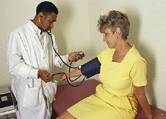- Skip Storing This Everyday Product in the Fridge Door
- Green Tea + B3 Pairing May Boost Brain Health
- Navigating Your Midlife Crisis: Embracing New Possibilities
- City Raccoons Showing Signs of Domestication
- Mapping the Exposome: Science Broadens Focus to Environmental Disease Triggers
- One Week Less on Social Media Linked to Better Mental Health
- Your Brain Changes in Stages as You Age, Study Finds
- Some Suicide Victims Show No Typical Warning Signs, Study Finds
- ByHeart Formula Faces Lawsuits After Babies Sickened With Botulism
- Switch to Vegan Diet Could Cut Your Greenhouse Gas Emissions in Half
Screen Everyone Over 45 for Diabetes: U.S. Task Force


Every American over the age of 45 should be screened for both type 2 diabetes and prediabetes, a U.S. task force has recommended.
“For people with abnormal blood sugar, changes in their lifestyle, such as eating healthier and exercising more often, can help prevent or delay the onset of type 2 diabetes. The best way to do that is to participate in a program that supports these behaviors. That’s why we’re recommending that people who are at increased risk be screened,” Dr. Michael Pignone, a member of the U.S. Preventive Services Task Force, said in news release from the independent panel of health experts.
Dr. Spyros Mezitis, an endocrinologist and clinical investigator at Lenox Hill Hospital in New York City, endorsed the task force’s recommendation.
“With diabetes and its major contributor, obesity, now at epidemic levels in the United States, the new U.S. Preventive Services Task Force recommendation to screen all adults at increased risk for type 2 diabetes makes good sense,” Mezitis said.
“For years, physicians have routinely screened all adults age 45 and older for diabetes with a simple, low-cost fasting blood sugar test. Expanding this screening to any adults over age 18 with diabetes risk factors such as obesity, family history, certain ethnicities, high blood pressure or high cholesterol levels will help us spot diabetes or prediabetes — now estimated to affect one-third of the U.S. population — much earlier at a low financial burden,” he said.
Dr. Jeffrey Powell, chief of the division of endocrinology at Northern Westchester Hospital in Mount Kisco, N.Y., added, “With such a high prevalence of diabetes and with potentially preventable but disabling complications, it makes sense to screen for this in the general population of adults.”
The number of Americans with type 2 diabetes has risen dramatically in the past 15 years, in tandem with the nation’s obesity epidemic. In 2012, 12 percent of adults had diabetes and 37 percent had prediabetes, which is a condition that includes moderately elevated blood sugar levels that raise the risk for diabetes.
Recent research has suggested that diagnosing prediabetes can lower a person’s chances of developing type 2 diabetes by 47 percent if the person eats more healthfully and exercises more, the Boston Globe reported.
The last time the task force visited the diabetes screening issue was in 2008, when it said diabetes screening was only needed for those at increased heart disease risk due to high blood pressure. At that time, there wasn’t much science showing the benefits of screening the general population, the newspaper reported.
“More evidence has emerged since then on the benefits of lifestyle interventions,” Pignone, a professor of medicine at the University of North Carolina School of Medicine, told the Globe. “Our feeling is that you need to have an effective intervention available for people that you screen.”
“The major risk factors for diabetes and abnormal blood sugar are increasing age and obesity,” task force member Dr. William Phillips, a professor of family medicine at the University of Washington in Seattle, said in the news release.
“Family history is another risk factor, such as having a parent, sibling or child with type 2 diabetes. In women, risk factors also include a history of polycystic ovarian syndrome or of diabetes while pregnant. Certain racial and ethnic groups are also at increased risk,” Phillips explained. The task force did not set any age guidelines for these high-risk groups.
Dr. Osama Hamdy, medical director of the obesity clinical program at Joslin Diabetes Center in Boston, told the Globe that the new recommendations will likely lead to a greater detection of high blood sugar levels at a point when diabetes can still be prevented.
“We need to focus on prevention rather than just treating a problem,” Hamdy said.
The task force’s draft recommendation is posted on its website and is open for public comment until Nov. 3.
More information
The U.S. Office of Disease Prevention and Health Promotion explains how to prevent type 2 diabetes.
Source: HealthDay
Copyright © 2025 HealthDay. All rights reserved.










